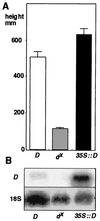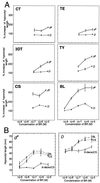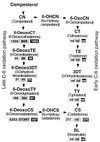The tomato DWARF enzyme catalyses C-6 oxidation in brassinosteroid biosynthesis
- PMID: 9990098
- PMCID: PMC15587
- DOI: 10.1073/pnas.96.4.1761
The tomato DWARF enzyme catalyses C-6 oxidation in brassinosteroid biosynthesis
Abstract
Brassinosteroids (BRs) are steroidal plant hormones essential for normal plant growth and development. Mutants in the biosynthesis or perception of BRs are usually dwarf. The tomato Dwarf gene (D), which was predicted to encode a cytochrome P450 enzyme (P450) with homology to other P450s involved in BR biosynthesis, was cloned previously. Here, we show that DWARF catalyses the C-6 oxidation of 6-deoxocastasterone (6-deoxoCS) to castasterone (CS), the immediate precursor of brassinolide. To do this, we first confirmed that the D cDNA complemented the mutant light- and dark-grown phenotypes of the extreme dwarf (dx) allele of tomato. To identify a substrate for the DWARF enzyme, exogenous application of BR intermediates to dx plants was carried out. C-6 oxoBR intermediates enhanced hypocotyl elongation whereas the C-6 deoxoBR, 6-deoxoCS, had little effect. Quantitative analysis of endogenous BR levels in tomato showed mainly the presence of 6-deoxoBRs. Furthermore, dx plants were found to lack CS and had a high level of 6-deoxoCS in comparison to D plants that had CS and a lower level of 6-deoxoCS. Confirmation that DWARF catalyzed the C-6 oxidation of 6-deoxoCS to CS was obtained by functional expression of DWARF in yeast. In these experiments, the intermediate 6alpha-hydroxycastasterone was identified, indicating that DWARF catalyzes two steps in BR biosynthesis. These data show that DWARF is involved in the C-6 oxidation in BR biosynthesis.
Figures





References
-
- Phinney B O, Spray C. In: Plant Growth Substances. Wareing P F, editor. London: Academic; 1982. pp. 101–110.
-
- Li J, Nagpal P, Vitart V, McMorris T C, Chory J. Science. 1996;272:398–401. - PubMed
-
- Szekeres M, Nemeth K, Koncz-Kalman Z, Mathur J, Kauschmann A, Altmann T, Redei G P, Nagy F, Schell J, Koncz C. Cell. 1996;85:171–182. - PubMed
LinkOut - more resources
Full Text Sources
Other Literature Sources

